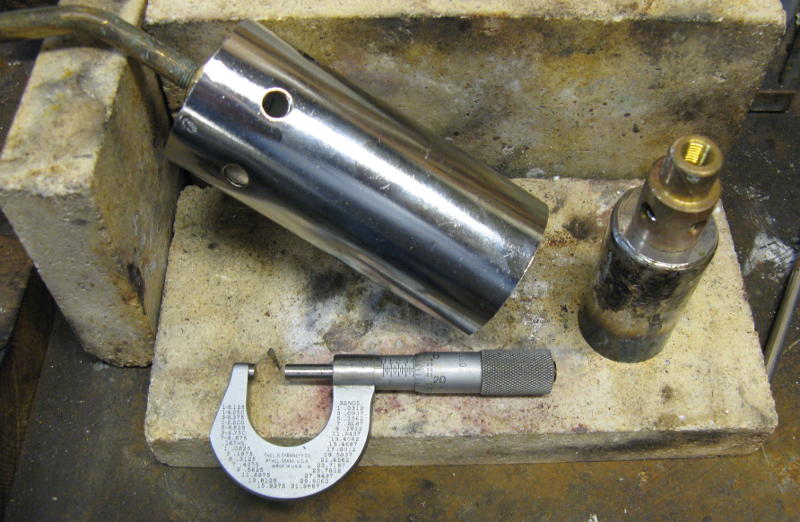I find silver solder flux doesn't flow well so coating all areas before assembly to which you intend solder to stick is helpful. You also need some space in the joints for the solder to flow into, maybe 0.005 thou. Basically, make your fits pretty loose.
You are using an out of date browser. It may not display this or other websites correctly.
You should upgrade or use an alternative browser.
You should upgrade or use an alternative browser.
Silver soldering 12L14 Steel
- Thread starter Harold Lee
- Start date

Help Support Home Model Engine Machinist Forum:
This site may earn a commission from merchant affiliate
links, including eBay, Amazon, and others.
jpeter said:I find silver solder flux doesn't flow well so coating all areas before assembly to which you intend solder to stick is helpful. You also need some space in the joints for the solder to flow into, maybe 0.005 thou. Basically, make your fits pretty loose.
I smear the flux on anything I expect to get braze, even if I think the flux will be removed when assembling. The are different "thicknesses" of silver solder - thin (easy flow) and gap fill (thick), the gaps needed for the thin stuff are a lot less. When you have a gap you can make it stay in assembly using a center punch to upset material - if used on a rod end in a hole it's maintain the gap you need all around while keeping it centered. I like to use one of the automatic center punches for that, keeps the punch size (and thus the upset height) even.
Good tips. I generally fixture the parts but seems the center punch idea has a lot of merit. I'm going to try it.rkepler said:I smear the flux on anything I expect to get braze, even if I think the flux will be removed when assembling. The are different "thicknesses" of silver solder - thin (easy flow) and gap fill (thick), the gaps needed for the thin stuff are a lot less. When you have a gap you can make it stay in assembly using a center punch to upset material - if used on a rod end in a hole it's maintain the gap you need all around while keeping it centered. I like to use one of the automatic center punches for that, keeps the punch size (and thus the upset height) even.
There's a lot to be said for using the right amount of heat too. Get silver solder too hot and it kinda ruins it. Not hot enough and it won't flow at all. With lots of flux on it and the heat just right its amazing stuff. Hard too to get something as large as a crank hot enough with a propane torch.
jpeter said:Hard too to get something as large as a crank hot enough with a propane torch.
There are propane torches and then there are propane torches:

The bigger one throws a flame about 3 feet and is good to about 4-5 inche diameter copper tube. The smaller one I use more and is good for most things I do. The torch handle connects to a 20# propane tank, the big tip will cause the tank to cool noticeably.
I never knew.rkepler said:There are propane torches and then there are propane torches:
You can get those giant propane torches as "weed burners" from Harbor Freight and similar. They are cheap. And LOUD. At full throttle, it's like a jet engine. Gobs of BTU's.
How about $19 for USA people?

Creating a "hearth" for such a process can be challenging. Firebrick works well. But one of the problems you get when using a giant torch in a hearth is that it's so big, the entire work area is enveloped in blue flame, it's hard to move, and it's hard to dab the solder into the gaps where you need it. That's why I prefer a hotter, hand-held torch that does more of a localized spot-heating. That's the thing with silver braze, you know when the temperature and flux is right... it flows beautifully. It's amazing when you see an internal braze fillet that has flowed into a 0.001" gap for several inches. You know that bond will NOT fail.
Nice tip with the center pop. Knurling will also do this. I think it is also wise to turn a groove in the tube's OD where the solder will go, and/or chamfer or bevel the ID of a tube, when brazing a solid or tube into another tube.
How about $19 for USA people?

Creating a "hearth" for such a process can be challenging. Firebrick works well. But one of the problems you get when using a giant torch in a hearth is that it's so big, the entire work area is enveloped in blue flame, it's hard to move, and it's hard to dab the solder into the gaps where you need it. That's why I prefer a hotter, hand-held torch that does more of a localized spot-heating. That's the thing with silver braze, you know when the temperature and flux is right... it flows beautifully. It's amazing when you see an internal braze fillet that has flowed into a 0.001" gap for several inches. You know that bond will NOT fail.
Nice tip with the center pop. Knurling will also do this. I think it is also wise to turn a groove in the tube's OD where the solder will go, and/or chamfer or bevel the ID of a tube, when brazing a solid or tube into another tube.

$59.99
Sunnytech Hot Air Stirling Engine Motor Model Educational Toy Electricity Generator Colorful LED (SC001)
stirlingtechonline

$190.00
$254.99
Genmitsu CNC 3018-PRO Router Kit GRBL Control 3 Axis Plastic Acrylic PCB PVC Wood Carving Milling Engraving Machine, XYZ Working Area 300x180x45mm
SainSmart Official

$45.99
Sunnytech Mini Hot Air Stirling Engine Motor Model Educational Toy Kits Electricity HA001
stirlingtechonline

$519.19
$699.00
FoxAlien Masuter Pro CNC Router Machine, Upgraded 3-Axis Engraving All-Metal Milling Machine for Wood Acrylic MDF Nylon Carving Cutting
FoxAlien Official

$94.99
$109.99
AHS Woodmaster 4400 Maintenance Kit for Outdoor Wood Boiler Treatment
Alternative Heating & Supplies

$188.98
TM NEXDYNAMI RE41157 Water Pump Compatible With/Replacement For/John Deere 6200 7400 6300 6600 6500 6400 7220 7600 7200 RE41157
VIVID MARKET CORPORATION

$99.99
$109.99
AmTech300 - Boiler Treatment Professional Strength (Rust Inhibitor For Outdoor Wood Boilers)
Alternative Heating & Supplies

$156.90 ($1.40 / oz)
Replacement Combustion Chamber Kit, Burnham V8 and V8H, 1-6 Sec, 108136-01, 1129
Lynn Manufacturing

$99.99
AHS Outdoor Wood Boiler Yearly Maintenance Kit with Water Treatment - ProTech 300 & Test Kit
Alternative Heating & Supplies

$39.99
$49.99
Sunnytech Low Temperature Stirling Engine Motor Steam Heat Education Model Toy Kit For mechanical skills (LT001)
stirlingtechonline

$403.09
DM14 Engine Build Kit, Metal Engine Build Model Great Metal Material for Engineer for Factory
Easoger Official
Similar threads
- Replies
- 15
- Views
- 2K





















































